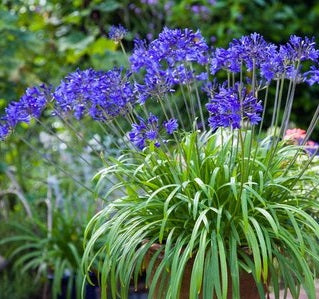Mastering the Art of Agapanthus Care: Necessary Steps for Healthy Development and Vivid Blossoms
In the realm of cultivation, the growing of agapanthus stands as a satisfying undertaking for those who seek to nurture these sophisticated flowering plants. With their striking flowers and stylish vegetation, agapanthus has captured the interest of garden enthusiasts worldwide. Nevertheless, achieving ideal development and lively blossoms calls for a nuanced method that encompasses different vital actions. From choosing the ideal variety to mastering trimming techniques, the journey towards cultivating growing agapanthus plants is multifaceted and holds the crucial to opening the complete capacity of these herb gems.

Choosing the Right Agapanthus Variety

When choosing the appropriate Agapanthus selection for your yard, consider variables such as environment suitability, flower color, and development habit. Additionally, take into consideration the environment in your area to guarantee the Agapanthus variety you select can flourish in your details conditions. Understanding the growth routine of various Agapanthus selections is vital for proper placement within your garden.
Suitable Growing Conditions
Considering the optimum ecological requirements is important for successful Agapanthus cultivation. Agapanthus flourishes in well-draining soil with a somewhat acidic to neutral pH degree. When planting, pick a place that receives full sunshine to partial color. In hotter environments, providing some afternoon shade can avoid scorching of the fallen leaves. Agapanthus plants are sensitive to cold temperatures and should be safeguarded from frost during winter season.
To guarantee healthy and balanced growth and vivid flowers, plant Agapanthus light bulbs at a depth of concerning 2-4 inches and room them 8-12 inches apart. Adding raw material, such as garden compost, to the dirt can boost drainage and fertility, advertising durable root growth. Mulching around the base of the plants aids maintain wetness and reduces weed growth. Regular watering is vital, particularly during the growing period, to maintain the dirt regularly wet yet not soaked.
Watering and Fertilizing Tips
Maintaining proper wetness degrees and offering vital nutrients are key elements in the care routine for Agapanthus plants. It is essential to strike a balance when it comes to watering Agapanthus. If overwatered, these plants favor consistently damp soil however are vulnerable to root rot. Throughout the growing season, water deeply once a week, ensuring the dirt is well-draining to stop waterlogging. In browse around this site hotter climates or during durations of dry spell, more frequent watering may be needed to keep the soil uniformly wet. However, lower watering in the winter months to stop waterlogged conditions.
Fertilizing Agapanthus is necessary for advertising healthy and balanced development and prolific flowers. Apply a balanced plant food, such as a 10-10-10 formula, in the early spring as new growth arises. By complying with these watering and fertilizing tips, you can ensure your Agapanthus plants prosper and generate vivid, durable blossoms.
Pruning Techniques for Agapanthus
Trimming Agapanthus plants at the proper times and with correct techniques is essential for maintaining their wellness and advertising optimum growth and flowering. The ideal time to trim Agapanthus is in late winter months or early springtime prior to new development arises.
Deadheading spent blossoms can likewise redirect the plant's energy into generating more flowers rather than establishing seeds. If you desire to accumulate seeds for breeding, leave some flowers to completely dry and fully grown on the plant.
Keep in mind to make use of clean, sharp devices to make exact cuts and this link reduce the danger of presenting conditions. Agapanthus. Routine pruning will assist maintain your Agapanthus looking cool and healthy while making certain an abundant screen of attractive blooms
Taking Care Of Common Pests and Conditions
After guaranteeing correct trimming methods for Agapanthus, it is necessary to deal with typical pests and illness that can influence the health and wellness and vigor of these plants. One common parasite that impacts Agapanthus is the Agapanthus gall midget.
Another usual issue is fungal fallen leave spot, which provides as dark lesions on the fallen leaves. To avoid fungal illness, make sure great air blood circulation around the plants, avoid above watering, and eliminate any kind of contaminated fallen leaves without delay. In addition, Agapanthus plants can experience origin rot if they are planted in badly draining dirt. To stop this, plant Agapanthus in well-draining soil and prevent overwatering. By being watchful and taking punctual action versus pests and illness, you can assist your Agapanthus plants grow and produce dynamic flowers.

Final Thought
Finally, understanding the art of agapanthus care includes selecting the ideal range, providing optimal planting conditions, appropriate watering and feeding, appropriate pruning methods, and resolving typical pests and illness. By complying with these essential actions, you can make sure healthy and balanced growth and vibrant blossoms for your agapanthus plants. Bear in mind to consistently monitor and maintain your plants to advertise their total health and longevity.
To make sure healthy development and dynamic blooms, plant Agapanthus bulbs at a deepness of regarding 2-4 inches and area them 8-12 inches apart. By following these watering and fertilizing pointers, you can guarantee your Agapanthus plants flourish and generate lively, durable flowers.
One common parasite that influences Agapanthus is the Agapanthus gall midget. Furthermore, Agapanthus plants can experience from origin rot if they are planted in inadequately draining pipes soil. By adhering to these important steps, you can make sure healthy development and vibrant blooms for your agapanthus click site plants.